*NURSING > Solutions Guide > ROSH REVIEW-Pediatrics Test bank Full answered each deeply explained. (All)
ROSH REVIEW-Pediatrics Test bank Full answered each deeply explained.
Document Content and Description Below
ROSH REVIEW-Pediatrics Test bank A 6-month-old infant presents to the pediatrician's office with a two-day history of increased fussiness, poor feeding, low-grade fever and rash. The family returne... d from a trip to India last week. The rash appears on the trunk in several stages of erythematous macules, vesicular papules and pustules. Which of the following is the most likely diagnosis? Herpes simplex Measles Pityriasis rosea Varicella - Correct Answer ( D ) Explanation: Varicella (chicken pox) is a highly contagious viral infection that is transmitted either through air-borne route or direct contact with the infected individual. The incubation period is 10-21 days. The infected individual is contagious for 2 days before the rash appears and until all the lesions have crusted over. There is a prodromal phase of malaise, headache, conjunctivitis, poor appetite and low-grade fever. The rash typically starts at the hairline, with formation of macules which progress to fluid-filled vesicles (dew drops on a rose pedal). Crops of lesions typically appear at the same time with vesicles in various stages of healing on the body. Infants have some immunity from maternal antibodies until 6 months of age. First dose of the varicella vaccine is given at 12 months of age. In healthy children < 12 years of age, chickenpox is usually a self-limited illness requiring only supportive care. Patients > 12 years of age are at higher risk for severe disease and should receive oral acyclovir. Immunocompromised patients should receive intravenous acyclovir. A previously healthy 17-year-old boy is brought to the ED by ambulance. He became very ill over the past few hours. His vital signs are T 39.4ºC, HR 142, BP 90/52, RR 20, and a pulse oximetry of 94% on room air. On exam, he has a stiff neck and the rash seen above on his leg. You establish an intravenous line, draw a blood culture, order a complete blood count and electrolyte assessment, and administer a fluid bolus. Which of the following is the most appropriate next step? Administer hydrocortisone to treat hemorrhagic adrenalitis (Waterhouse-Friderichsen syndrome) Administer intravenous ceftriaxone and vancomycin Perform a CT scan of the head Perform a lumbar puncture - Correct Answer ( B ) Explanation: This patient is presenting with severe meningococcal septicemia caused by the aerobic gram-negative diplococcus N. meningitidis, a natural organism living in the nasopharynx of humans, its only host. Patients with this infection may progress rapidly. The lumbar puncture may be deferred until the patient is stable and should not delay antibiotic administration. Although N. meningitides continues to be sensitive to penicillin, ceftriaxone and vancomycin should be administered to cover for N. meningitides and resistant pneumococcal meningitis, which may also cause purpura fulminans. Hemorrhagic adrenalitis is an adrenal gland failure due to bleeding into the adrenal glands, caused by severe bacterial infection (most commonly N. meningitidis). The bacterial infection leads to massive hemorrhage into one or (usually) both adrenal glands. Treatment with antibiotics is the primary treatment. Hydrocortisone (A) can sometimes reverse the hypoadrenal shock. Although the patient's mental status change can indicate an elevated intracranial pressure from meningococcal meningitis inflammatory changes, his presentation with low blood pressure and tachycardia is more consistent with severe meningococcal septicemia. A 7-year-old girl presents to urgent care complaining of vaginal irritation over the last several days. Mom noticed that the patient's vaginal area is abnormally red and irritated and that her underwear has been slightly damp. The patient denies bleeding, urinary complaints, or abdominal pain. On exam, the patient's vulva appears erythematous and a small amount of whitish discharge is present. There is no foul odor, bleeding, or abnormal lesions present. Which of the following is the most likely cause of the patient's presentation? Bacterial vulvovaginitis Foreign body Irritant vulvovaginitis Sexual abuse - Correct Answer ( C ) Explanation: Irritant or nonspecific vulvovaginitis is the most common cause of vulvar irritation in prepubertal girls. Patients may present with or without a thin, whitish, non-foul-smelling discharge. Vulvar irritation may occur as the result of poor hygiene, such as wiping from back to front or not wiping adequately after urination, or secondary to chemical irritants, such as bubble bath, perfumed soaps, or clothes washed in strong detergent. Tightly fitting clothing such as leotards, bathing suits, tights, spandex, and nylon underwear can also be irritants. Factors which may increase the overall risk of vulvovaginitis include obesity, a relatively alkaline pH, thin vaginal mucosa, and small labia minora. Vulvovaginitis can be both treated and prevented by adopting thorough hygiene measures, avoiding bubble baths, and keeping soap away from direct contact with the genital area. Wearing 100% cotton underwear, avoiding tight clothes, and quickly removing wet bathing suits should be advised. Bacterial vulvovaginitis (A) typically presents acutely with foul-smelling vaginal discharge associated with erythema, burning, itching, and soreness. One Step Further Question: What is the most common pathogen implicated in bacterial vulvovaginitis? - Answer: Group A β-hemolytic streptococcus. A boy aged 30 months presents with respiratory distress. He was diagnosed with croup one week ago and received a single dose of dexamethasone. His cough had nearly resolved until yesterday, when coughing worsened, and he developed nasal congestion. This evening, he developed inspiratory stridor, increased work of breathing, and a fever to 103°F. What is the most likely diagnosis? Bacterial tracheitis Bronchiolitis Foreign body aspiration Recurrent croup - Correct Answer ( A ) Explanation: Bacterial tracheitis is a rare upper airway obstruction in children. It may occur in isolation or following a viral respiratory illness, including croup. Bacterial tracheitis should be suspected in any child with clinical worsening after improvement of croup symptoms. In children without a preceding illness, symptom onset may begin insidiously with one to three days of viral upper respiratory infections prior to decompensation with respiratory distress, inspiratory stridor, and high fevers. Other children will not demonstrate prodromal symptoms and will present acutely toxic and in extremis. The most common causative organism is Staphylococcus aureus. Less common causes include S.pneumoniae, S.pyogenes, M.catarrhalis, and H.influenzae. Endoscopy is necessary to establishing a definitive diagnosis, but it should take place in a setting where airway supplies and personnel are readily available, such as the operating room or the intensive care unit. Bronchiolitis (B) would be expected to show signs of lower respiratory tract involvement such as crackles and wheezes on examination. Moreover, the child's acute worsening of symptoms of upper respiratory infection following an episode of croup should raise suspicion for bacterial superinfection rather than acquisition of a new viral respiratory infection Recurrent croup (D) would be unexpected in an otherwise healthy child who had been improving throughout the week following treatment with dexamethasone. One Step Further Question: What radiographic sign is present in both croup and bacterial tracheitis? - Answer: Steeple sign. A 2-year-old boy is being evaluated for dysphagia and difficulty breathing. His mother tells you his symptoms suddenly began about 3-hours ago. His immunizations are up to date. He appears restless, irritable, and is drooling. His temperature is 40.0°C (104°F). Physical examination shows suprasternal and subcostal retractions. Auscultation of the lungs reveals inspiratory stridor. Blood cultures are pending. Which of the following is the most appropriate treatment for this patient's condition? Albuterol Ampicillin Ceftriaxone + vancomycin Prednisone - Correct Answer ( C ) Explanation: The constellation of symptoms most likely indicates acute epiglottitis. Epiglottitis is the inflammation of the epiglottis and adjacent supraglottic structures and results from bacteremia and/or direct invasion of the epithelial layer by the pathogenic organism. Although, Haemophilus influenzae type b (Hib) is the most common infectious cause of epiglottitis in children, empiric antimicrobial therapy should be directed towards penicillin-resistant Streptococcus pneumonia, Beta-hemolytic streptococci, and Staphylococcus aureus, including community-acquired methicillin-resistant S. aureus (MRSA) strains. The most effective therapy is a combination of a third-generation cephalosporin (eg, ceftriaxone or cefotaxime) and an antistaphylococcal agent active against MRSA (eg, clindamycin, vancomycin). Due to airway compromise, patients with suspected epiglottitis should have their airway emergently stabilized in the operating room. This should occur concomitantly or prior to antibiotic administration. 12-year-old girl presents with right hip pain after kicking a ball to score at her soccer game. She describes hearing a "pop" followed by immediate pain. The patient can limp and localizes pain to the anterior right hip. An X-ray is obtained as seen above. Which of the following is the most appropriate management? Immobilization with a spica cast Muscle relaxant and heat Non-weight-bearing and pain control Surgical pinning - Correct Answer ( C ) Explanation: The patient has a pelvic avulsion fracture of the anterior inferior iliac spine (AIIS). This is the result of forced muscle contraction, causing a fracture at the muscular origin. The commonly fractured pelvic apophysis locations in descending order of incidence include ischial, anterior inferior iliac spine, anterior superior iliac spine, superior pubic ramus, and iliac crest. Risk factors include sports such as gymnastics, soccer, and hurdles. Prevention is through stretching of the commonly involved muscles including the sartorius, rectus femoris, hamstring, iliopsosas, and leg adductor muscles prior to participating in sports. Diagnosis is with plain radiographs of the pelvis in anterior posterior and frog leg views. Pelvic avulsions rarely require pinning and most often successfully heal with crutch use and pain control. Occasionally, this type of injury heals with excessive callus formation. Sport activity should be limited for four to six weeks. One Step Further Question: Forceful contraction of which muscle is responsible for causing the most common type of pelvic avulsion fracture? - Answer: Hamstring muscle. A two-month-old infant presents with two weeks of nasal congestion and cough. Over the past two days, the cough has acutely worsened. Her family describes discrete episodes of coughing and gagging, sometimes followed by emesis. She appears well between coughing episodes. What treatment is indicated? Honey Intramuscular ceftriaxone Oral azithromycin Supportive care - Correct Answer ( C ) Explanation: The infant has a presentation consistent with Bordetella pertussis infection. Pertussis is spread through aerosolized droplets. After a seven- to 14-day incubation period, symptoms begin with nasal congestion, cough, and low-grade fever. This period, known as the catarrhal phase, lasts one to two weeks. Subsequently, the infant progresses to the paroxysmal phase, which includes episodic, "rapid fire," repetitive coughing. The coughing may include cyanosis, salivation, and lacrimation. The cough is classically followed by an inspiratory "whoop." The whoop is most common in infants older than six months of age. The whoop is uncommon among older children and adolescents. The intensity of coughing may also result in post-tussive emesis. The paroxysmal stage typically lasts for four weeks. The child will then progress to the convalescent phase, during which he or she will gradually have decreasing frequency and severity of coughing episodes. The convalescent stage may last for a few weeks to several months. Children with pertussis remain contagious until B. pertussis is eradicated from their nasopharynx. Spontaneous clearance typically occurs in two to four weeks. Oral azithromycin is the drug of choice for rapidly eradicating B. pertussis from the nasopharynx. Its dosing is 10 mg/kg for five days, which is notably different from recommended dosing for community-acquired pneumonia. Treatment will not result in symptom resolution, but the child will no longer be contagious. One Step Further Question: At what ages is the DTaP vaccine recommended? - Answer: Two months, four months, six months, 15 to 18 months and four to six years. 12-year-old Hispanic girl is seen in the clinic with her parents because of painful joints. History reveals that arthralgias started six months ago which affected both knee joints and all metacarpophalangeal joints of the left hand. She has associated fatigue and occasional fever. Physical examination reveals oral mucosal ulcers, discoid rash with malar distribution, and vasculitic rash on the toes. Complete blood count showed white blood count 6.1 x 109/L, neutrophils 4 x 109/L, bands 0.9 x 109/L, lymphocytes 0.5 x 109/L, monocytes 0.4 x 109/L, eosinophils 0.3 x 109/L, and platelets 84 x 109/L. Which of the following tests is most specific for the diagnosis of the patient's condition? Anti-ribonucleoprotein antibody Anti-Smith antibody Antihistone antibodies Antinuclear antibody (ANA) - Correct Answer ( B ) Explanation: The patient is suffering from systemic lupus erythematosus (SLE). SLE is a chronic autoimmune disease characterized by multisystem inflammation and the presence of circulating autoantibodies directed against self-antigens. SLE occurs in both children and adults, disproportionately affecting females of reproductive age. Prevalence of SLE is highest among African-Americans, Asians, Hispanics, Native Americans, and Pacific Islanders for both adult and pediatric populations. SLE predominantly affects females, with reported 2-5:1 ratio prior to puberty, 9:1 ratio during reproductive years, and return to near prepubertal ratios in the postmenopausal period. Childhood SLE is rare before 5 years of age and is usually diagnosed in adolescence, with a median age at diagnosis of 11-12 years. Histologic features most suggestive of SLE includes findings in the kidney and skin, especially the discoid rash. The characteristic discoid rash is characterized on biopsy by hyperkeratosis, follicular plugging and infiltration of mononuclear cells into the dermal-epidermal junction. The most common presenting complaints of children with SLE include fever, fatigue, hematologic abnormalities, arthralgia and arthritis. Arthritis is usually present in the first year of diagnosis. It is often a symmetric polyarthritis affecting large and small joints. Presence of at least 4 out of the 11 criteria set by the American College of Rheumatology (ACR) 1997 Revised Classification for SLE, either simultaneously or cumulatively over time, establishes the diagnosis of SLE. The criteria includes the following: malar rash, discoid rash, photosensitivity, oral or nasal ulcers, arthritis (nonerosive, ≥ 2 joints), serositis (pleuritis, pericarditis or peritonitis), renal manifestations (consistent renal biopsy, persistent proteinuria or renal casts), seizure or psychosis, hematologic manifestations (hemolytic anemia, leukopenia, lymphopenia, or thrombocytopenia), immunologic abnormalities (positive anti-double-stranded DNA or anti-Smith antibody, false positive rapid plasma reagin test result, positive lupus anticoagulant test result or elevated anticardiolipin IgG or IgM antibody) and positive antinuclear antibody test. Four of the eleven criteria are present in this girl which establishes the diagnosis of SLE. Of the various immunologic tests, anti-Smith antibody is the most specific (about 98%) for the diagnosis of SLE, but it is not sensitive (40-65%). A 3-week-old baby girl with an unknown birth history presents to the emergency department with 3 days of poor feeding and recurrent cyanotic episodes. On exam, she is agitated, tachypneic, tachycardic with central cyanosis and a harsh systolic crescendo decrescendo murmur along the left mid-to-upper sternal border. An arterial oxygen saturation is 78% and a chest X-ray shows a boot-shaped heart. What is the best initial step in management? Administer morphine 0.2 mg/kg IM Administer propanolol 0.01 mg/kg IV Console the child in a knee-chest position Start positive pressure ventilation - Correct Answer ( C ) Explanation: This clinical scenario describes a hypercyanotic episode, also known as a 'tet spell' that can occur in children with Tetrology of Fallot (TOF). The four associated abnormalities in TOF are right ventricular hypertrophy, right ventricular outflow tract obstruction, ventricular septal defect and an over-riding aorta. Classic chest X-ray findings of TOF include a normal sized but boot-shaped heart reflecting the right ventricle with decreased pulmonary vascularity. TOF anomalies can lead to decreased pulmonary flow and right-to-left shunting through the VSD. A 'tet spell' can occur with decreased systemic vascular resistance that can result from hypotension, exertion during feeding, crying, defecation and tachycardia. This leads to increased right-to-left shunting of the blood across the VSD. The cyanotic episode is usually 15 to 30 minutes long but can lead to stroke, seizures and even death. During a spell, patients can have a right ventricular outflow tract obstruction murmur (harsh systolic crescendo decrescendo murmur along the mid-to-upper sternal border) and a VSD murmur (harsh pansystolic murmur heard best at the lower left sternal border). Management of spells aims to increase systemic vascular resistance, correct hypoxia and correct acidemia. Initial steps include administering high-flow oxygen by mask, consoling the child by cradling them in a knee-chest position, and avoiding exacerbating distress. Underlying arrhythmia, hypothermia, and hypoglycemia should also be corrected. One Step Further Question: Which chromosome abnormality is Tetralogy of Fallot associated with? - Answer: It is associated with chromosome 22 deletions and DiGeorge syndrome. A five-year-old boy is brought to the ED by his mother for leg pain. He was playing with his sister when he fell and cried. He cannot move his right lower leg. The mother had a hard time explaining how the boy sustained the injury. She said he had several fractures in the past. His father also has history of multiple fractures and hearing loss. On examination, the boy's height is at the 5th percentile, he has normal motor and sensory examination of the right foot and ankle with strong pulses, slight swelling of the right leg with tenderness at the tibia. You suspect a right tibial fracture. Which of the following is the most likely diagnosis? Child abuse Osteogenesis imperfecta Osteomalacia Rickets - Correct Answer ( B ) Explanation: The boy has history of multiple fractures with a family history of multiple fractures and hearing loss. These findings are suspicious for osteogenesis imperfecta (OI). OI or "brittle bone disease" is an inherited connective tissue disorder. Most patients have an autosomal dominant mutation in the gene that affects the structure of one of the two alpha chains of type I collagen. The severity of the clinical presentation depends upon the effect of the mutation. The clinical manifestations vary within families. Clinical manifestations of OI include excess or atypical fractures, short stature, scoliosis, basilar skull deformities, blue sclerae, hearing loss, opalescent teeth that wear quickly, increased laxity of the ligaments and skin, wormian bones, and easy bruisability. There are reports of elevated alkaline phosphatase and hypercalciuria. The clinical diagnosis is based on the signs and symptoms as described, which is straightforward in individuals with bone fragility and a positive family history or several extraskeletal manifestations. Osteomalacia (C) can present as bone pain, fractures, and alkaline phosphatase elevation. Hearing loss or blue sclerae are not present. Rickets (D) can lead to slow growth, bone deformities, elevation of alkaline phosphatase, defective bone mineralization, and abnormal tooth formation. However, scleral abnormalities and hearing loss typically do not occur. A 5-month-old girl presents to the ED with her parents who are concerned about brief episodes of "whole body muscle contraction." On physical exam, the child has poor head control and absent palmar grasp. Her electroencephalogram shows hypsarrhythmia. Which of the following is the most likely diagnosis? Cerebral palsy Infantile spasms Kernicterus Tay-Sachs disease - Correct Answer ( B ) Explanation: This patient is presenting with signs and symptoms consistent with infantile spasms or West syndrome. Infantile spasms are defined by the triad of findings: (1) clusters of myoclonic seizures on awakening, (2) hypsarrhythmia pattern on electroencephalogram, and (3) developmental delay. Signs and symptoms of infantile spasms usually begin at 4-8 months of age. Infants will demonstrate brief contractions of the neck, trunk, and extremities lasting 5 to 10 seconds each, occurring in clusters. These episodes may be accompanied by a cry. Imaging of the brain with CT or MRI is often abnormal; however, it is not diagnostic of infantile spasms. These children are most frequently diagnosed by the presence of the characteristic electroencephalogram (EEG) finding of hypsarrhythmia, which has the appearance of high amplitude irregular waves and spikes in a background of chaotic and disorganized activity. A lumbar puncture should also be considered and performed to rule out meningitis or encephalitis. Management of infantile spasms is primarily with adrenocorticotropic hormone (ACTH), prednisone, and antiepileptic medications. Cerebral palsy (A) may present with seizures and developmental delay; however, the child will also typically have other findings including muscular spasticity. Hypsarrhythmia is also nearly pathognomonic for the diagnosis of infantile spasms. Kernicterus (C) will usually present with jaundice and hypotonia. Tay-Sachs disease (D) presents with muscle atrophy beginning at age 6 months and an abnormal funduscopic exam with blindness. Which of the following is the most common congenital heart defect? Atrial septal defect Coarctation of the aorta Patent ductus arteriosus Ventricular septal defect - Correct Answer ( D ) Explanation: Ventricular septal defect (VSD) is most common, responsible for 25% of all congenital heart defects. Most are small and close spontaneously over time. However, larger lesions may persist, eventually leading to pulmonary hypertension and right-sided heart failure. The classic VSD murmur is holosystolic and best heard at the left lower sternal border One Step Further Question: What syndrome is associated with a VSD that results in right-to-left shunting? - Answer: Eisenmenger syndrome. Progressive high pulmonary vascular pressure alters flow from left to right through the VSD to right to left, leading to cyanosis. Which one of the following children should undergo testing for streptococcal pharyngitis? A 16-year-old with pharyngitis, rhinorrhea, and voice hoarseness A 2-year-old with fever and cough A 5-year-old with fever, cough, and tender anterior cervical lymphadenopathy A 9-year-old asymptomatic household contact whose brother was recently diagnosed with acute streptococcal pharyngitis - Correct Answer ( C ) Explanation: Pharyngitis has many etiologies including infectious (bacterial, viral, fungal), GERD, trauma, toxins, and malignancy. Bacterial pharyngitis is most commonly caused by group A strep (GAS). Testing and treatment for group A strep are based on the Centor criteria (1) Temperature >38°C; (2) Tender anterior cervical lymphadenopathy; (3) Absence of cough; (4) Presence of pharyngotonsillar exudates; (5) Age <15 years; (6) Age >45 years subtracts a point. Rapid antigen testing should be obtained in patients suspected of having bacterial pharyngitis who have 2-3 positive features of the Centor criteria. When an appropriate sample is obtained, the rapid antigen test has a sensitivity around 70% to 90%. However, a negative rapid strep test still requires a throat culture given the high false negatives. In patients who have 4 out of 4 elements of the Centor criteria, the positive predictive value for strep pharyngitis is 60% and the patient should be treated empirically and no rapid strep test obtained. For 2-3 Centor criteria, a rapid strep test should be sent and treatment initiated if positive. If negative, a confirmatory throat culture should be sent and treatment held until culture results are available. Centor criteria of 0-1 has a negative predictive value of 70%+ and no testing or treatment should be initiated. Treatment of strep pharyngitis remains to be penicillin. The patient in the above scenario has three Centor criteria (age < 15, fever, and tender anterior cervical lymphadenopathy) and should undergo rapid antigen testing for group A streptococcal pharyngitis. An 8-year-old girl presents to the emergency department with a one-day history of rash. The rash is erythematous, macular, blanching, and covers her trunk and extremities. It is not painful or pruritic, and there are no vesicles, bullae or mucosal lesions noted. She has bilateral lymphadenopathy in the posterior cervical chains with splenomegaly on palpation of her abdomen. The rest of her physical exam is normal. Her pediatrician started an antibiotic last week for pharyngitis but she has not improved. What is the most likely etiology of her rash? DRESS Syndrome Mononucleosis Stevens-Johnson Syndrome Type I Hypersensitivity reaction - Correct Answer ( B ) Explanation: Mononucleosis is caused by the Epstein Barr virus (EBV) and presents clinically with fatigue, fever, pharyngitis, lymphadenopathy, and splenomegaly. Mononucleosis is associated with a faint, widespread, non-pruritic rash, which lasts for about a week. It is characterized by patches that may contain small bumpy red spots. It thought to be directly due to the virus. This rash often appears on the trunk and upper arms first, and a few days later extends to involve the face and forearms. This is in contrast to a more intense pruritic maculopapular or morbilliform which appears on extensor surfaces and pressure points 7 to 10 days after treatment with beta-lactam antibiotics such as ampicillin, amoxicillin and cephalosporins. This rash indicates a hypersensitivity reaction to the antibiotic. It is not a true allergy and does not occur if the antibiotic is given later on in the absence of EBV infection.The peak incidence of infection with EBV occurs in adolescence. The diagnosis can be made with EBV IgM and IgG or EBV PCR. Rare but life-threatening complications of mononucleosis include splenic rupture; therefore patients with mononucleosis should be instructed to avoid contact sports until their illness has resolved. Type 1 Hypersensitivity reactions (D) occur immediately after exposure to the antigen, rather than after 1 week of exposure. These reactions can present with urticaria, bronchospasm, or anaphylaxis. DRESS Syndrome (A), or drug-induced hypersensitivity syndrome, typically presents with fever, severe exanthematous rash that can be exfoliative, generalized lymphadenopathy, and hematologic abnormalities. It is usually associated with anticonvulsants, as well as minocycline, sulfonamides, nitrofurantoin, and allopurinol. This syndrome can be life threatening due to organ damage such as carditis, hepatitis, and nephritis. Eosinophilia is present in up to 50% of cases. Mucosal lesions are rarely seen in this disorder, differentiating it from Stevens-Johnson syndrome or toxic epidermal necrolysis. One Step Further Question: Which malignancy is associated with Epstein Barr Virus? - Answer: Burkitt's lymphoma. A 13-year-old boy presents to the Emergency Department with thigh pain. His symptoms worsened after jumping into a swimming pool. On physical exam, he is a well-developed, obese boy who ambulates with a limp. The hip is externally rotated and adducted. X-rays of the pelvis are taken and shown above. What is the most likely diagnosis? Congenital hip dislocation Legg-Calvé-Perthes disease Slipped capital femoral epiphysis Transient synovitis - Correct Answer ( C ) Explanation: This patient presents with slipped capital femoral epiphysis (SCFE). SCFE is characterized by displacement of the capital femoral epiphysis from the femoral neck through the growth plate. It affects predominantly obese adolescents. Males and African-American children are more commonly affected. Patients present with dull, aching hip, groin, thigh or knee pain, typically without any significant preceding trauma. Physical exam reveals external rotation and adduction at the hip. The diagnosis is confirmed by AP and lateral X-rays. The slipped epiphysis resembles "ice cream falling off the cone" and an abnormal Klein line. A straight line drawn along the lateral aspect of the femoral neck normally intersects the femoral head, whereas this line passes outside of the epiphysis in patients with SCFE. Orthopedic evaluation is essential, as treatment is almost always operative. The most feared complication of SCFE is osteonecrosis of the femoral head. Congenital hip dislocation (A) typically affects Caucasian firstborn females < 1 year of age. Legg-Calvé-Perthes (B) is an idiopathic avascular necrosis of the femoral head in school-aged children. Transient synovitis (D) presents with hip, thigh or knee pain after a recent upper respiratory infection. A 2-year-old boy presents to the emergency department with difficulty breathing. His mother notes "a cold" that began this morning with a fever to 101.3°F. He then developed a barky cough and harsh breathing. On examination, you note he is tachypneic with suprasternal and subcostal retractions and stridor with every breath. The most appropriate next step is administration of which of the following? Albuterol Dexamethasone Ipratropium Racemic epinephrine - Correct Answer ( D ) Explanation: In a febrile child, croup (laryngotracheitis) is by far the most common cause of stridor. It is a viral infection most commonly due to parainfluenza virus that leads to inflammation of the upper airway. Croup typically affects children between 7 months and 3 years of age, but can happen at any age. It typically starts with an upper respiratory febrile illness that progresses to a barky, "seal-like" cough in the first 1-2 days. Stridor at rest associated with tachypnea or increased work of breathing indicates a severe case. In severe croup, racemic epinephrine should be the first line therapy. Racemic epinephrine stimulates alpha and beta adrenergic receptors in the airway resulting in mucosal constriction and smooth muscle relaxation. Onset is rapid, and the duration of action is about 2 hours One Step Further Question: What is the natural history of croup? - Answer: Stridor typically resolves after 48 hours, after which typical upper respiratory symptoms predominate A 1-week-old boy born at full term to a 16-year-old primigravida mother with no complications presents to the ED for lethargy. In the ED, his vital signs are T 37°C, HR 166, RR 82, and pulse oximetry of 80%. On exam, he is lethargic with diffuse pulmonary rales and rhonchi, cold extremity, and decreased peripheral pulses. Given concern for ductal-dependent cardiac lesion, you administer prostaglandin E1 (PGE1) infusion. Which of the following is a known adverse reaction of a PGE1 infusion? Apnea Hypertension Hypothermia Thrombocytosis - Correct Answer ( A ) Explanation: The patient in this vignette has a ductal-dependent cardiac lesion that requires a patent ductus arteriosus (PDA) to preserve blood flow from the aorta to the pulmonary artery. At approximately 1 week of age, the PDA may close and cause sudden cardiovascular collapse. PGE1 infusion is potentially life-saving, but it is important to be aware of its adverse reactions. For example, apnea is a known adverse reaction of PGE1 infusion; therefore, it is important to secure the airway with endotracheal intubation prior to its infusion. Other reactions include fever, not hypothermia (C); hypotension, not hypertension (B); decreased platelet aggregation, not thrombocytosis (D), seizures; bradycardia; and flushing. It is important to anticipate these effects and have additional IV fluid boluses, fresh frozen plasma, and seizure medications prepared. Most patients should be prophylactically intubated. A two-year-old previously healthy boy is witnessed having a tonic-clonic seizure in the emergency room. Mom originally brought him in due to a fever of 39°C. The episode lasted five minutes, and the patient returned to baseline mental status. Which of the following is the most appropriate next step in management? Administer antipyretics Initiate anticonvulsant therapy Perform a lumbar puncture Perform an EEG - Correct Answer ( A ) Explanation: Febrile seizures are seizures that occur between the ages of six months and 60 months with a temperature of 38°C or higher, that are not the result of a central nervous system infection or any metabolic imbalance and that occur in the absence of a history of prior afebrile seizures. A simple febrile seizure is a primary generalized, usually tonic-clonic attack associated with fever, lasting for a maximum of 15 minutes and not recurring within a 24-hour period. A complex febrile seizure is more prolonged (>15 min), is focal or recurs within 24 hours. Treatment is mainly supportive for simple febrile seizures and involves evaluation of the fever source, control of fevers with antipyretics such as acetaminophen (not aspirin), and reassurance of the parents. One Step Further Question: Which antiepileptic medication can cause hirsutism and gingival hyperplasia? - Answer: Phenytoin. A 7-year-old boy presents with a fever, cough, runny nose, and conjunctivitis for 3 days followed by the above pictured rash that initially appeared on his face. Exam of his oral mucosa reveals pinpoint gray spots. Which of the following is the most likely diagnosis? Erythema infectiosum Measles Rocky Mountain spotted fever Rubella - Correct Answer ( B ) Explanation: This patient has a typical presentation for measles (rubeola). The measles virus is a respiratory tract pathogen that is highly communicable. After exposure, the virus incubates for 10-14 days. The patient then develops cough, coryza and conjunctivitis along with fever. 2-4 days later, the characteristic rash begins on the face and spreads down the trunk then fades in a head-to-toe direction. Additionally, Koplik's spots, pinpoint gray spots with surrounding red inflammation, develop on the buccal mucosa and are pathognomonic for measles. Treatment is supportive Erythema infectiosum (A) is usually a nonfebrile disease. Rubella (D) is also characterized by a maculopapular rash and fever but does not have Koplik's spots. Rocky Mountain Spotted Fever (C) results from a tick bite and starts on the extremities and moves centrally. One Step Further Question: How is the Measels virus spread? - Answer: It is spread through infectious droplets and is highly contagious. A mother brings her 4-year-old previously healthy daughter to clinic for vaginal itching and erythema. The mother is the primary care provider for the child and does not suspect abuse. On exam there is no discharge, the vulva appears erythematous, and the hymen is intact, thin and pinkish-red. Which of the following is the most appropriate management? Advise the avoidance of strong detergents and bubble baths Immediately call Child Protective Services Obtain gonorrhea and chlamydia DNA probes Prescribe acyclovir - Correct Answer ( A ) Explanation: Vulvovaginitis presents with vaginal irritation, pain, and pruritus. Irritant vulvovaginitis is the most common cause of genital complaints in prepubertal girls. Tight clothing is also a cause. Vulvitis refers to the external genital pruritus, burning, redness, or rash. Vaginitis implies inflammation of the vagina, which manifests as ******TBContinued [Show More]
Last updated: 1 year ago
Preview 1 out of 166 pages
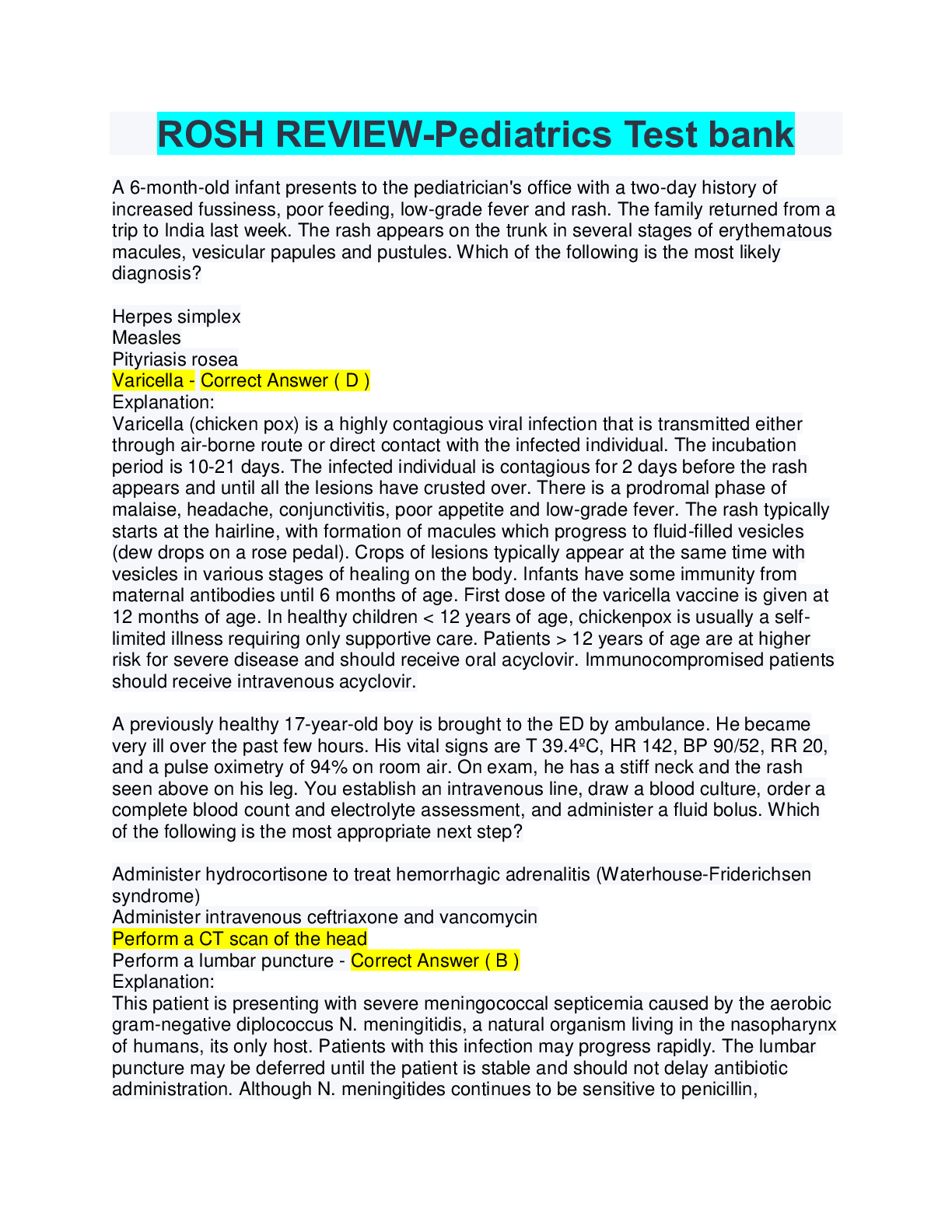
Reviews( 0 )
Recommended For You
Emergency Medicine> Solutions Guide > EMT--Basic Review for NREMT CBT Examinations | EMT--Basic Review for NREMT CBT Exam Test Bank Full (All)
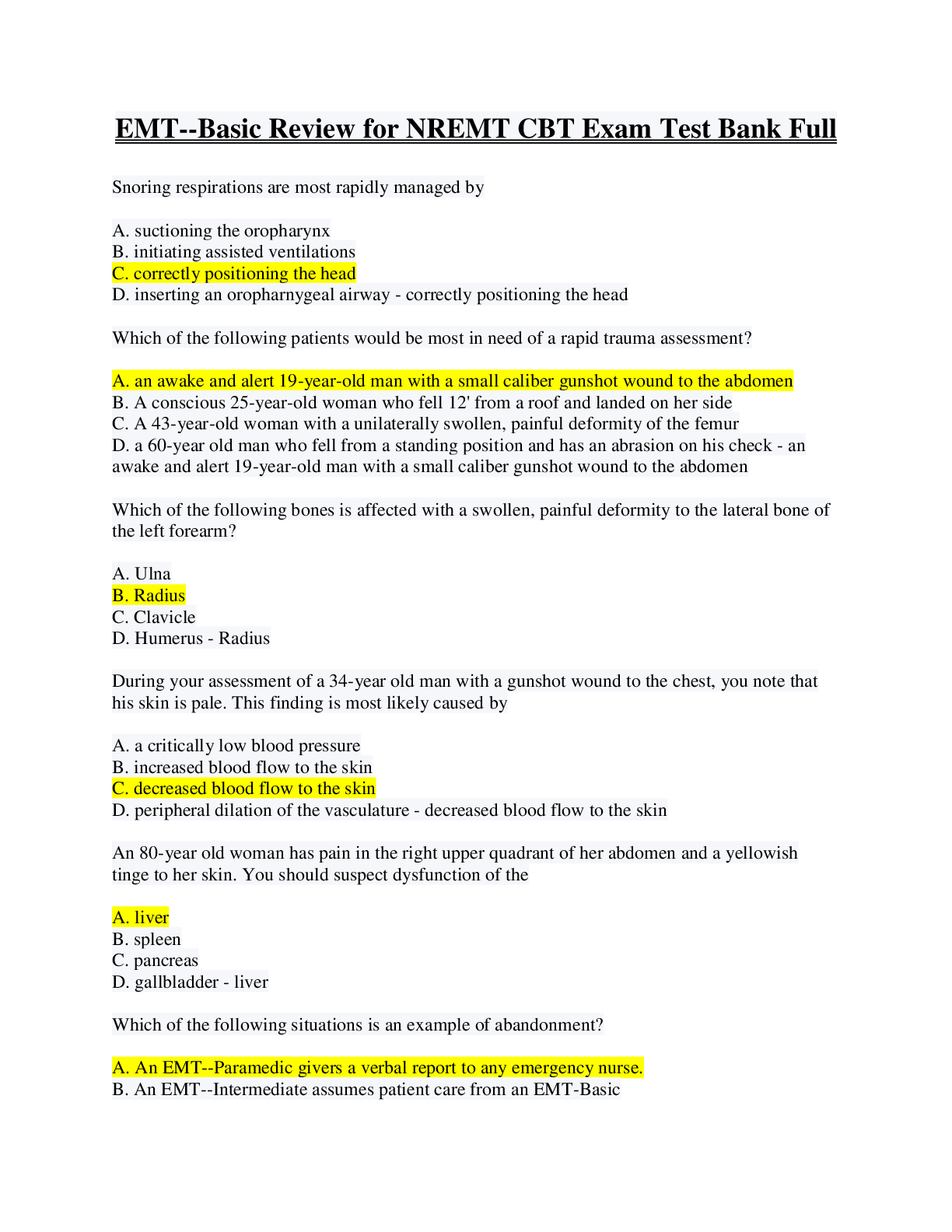
EMT--Basic Review for NREMT CBT Examinations | EMT--Basic Review for NREMT CBT Exam Test Bank Full
EMT--Basic Review for NREMT CBT Exam Test Bank Full Snoring respirations are most rapidly managed by A. suctioning the oropharynx B. initiating assisted ventilations C. correctly positioning t...
By CoursesExams , Uploaded: Jul 01, 2022
$15
Managerial Economics> Solutions Guide > Managerial Economics in a Global Economy 8th Edition By Dominick Salvatore (Solutions Manual ) (All)

Managerial Economics in a Global Economy 8th Edition By Dominick Salvatore (Solutions Manual )
Reflecting the highly globalized nature of tastes, production, labor markets, and financial markets in today's world, Managerial Economics in a Global Economy, Eighth Edition, presents the theory of t...
By eBookSmTb , Uploaded: Jun 01, 2022
$20
Business Administration> Solutions Guide > Australasian Business Statistics 4th Edition By Black, Asafu ,Adjaye, Burke, Khan, King, Perera, Papadimos, Sherwood, Wasimi (Solution Manual All Chapters) (All)

Australasian Business Statistics 4th Edition By Black, Asafu ,Adjaye, Burke, Khan, King, Perera, Papadimos, Sherwood, Wasimi (Solution Manual All Chapters)
Data-driven decisions are driving the global knowledge economy. To get the edge, graduates need the power of statistical analysis to create business insight. This fourth edition of Australasian Busine...
By eBookSmTb , Uploaded: Nov 23, 2021
$20
Business Law> Solutions Guide > International Economics Theory and Policy 12th edition By Paul R. Krugman, Maurice Obstfeld, Marc Melitz (Solutions Manual ) (All)

International Economics Theory and Policy 12th edition By Paul R. Krugman, Maurice Obstfeld, Marc Melitz (Solutions Manual )
1. Introduction PART 1: INTERNATIONAL TRADE THEORY 2. Word Trade: An Overview 3. Labor Productivity and Comparative Advantage: The Ricardian Model 4. Specific Factors and Income Distribution 5....
By eBookSmTb , Uploaded: Nov 05, 2022
$25
Education> Solutions Guide > Essentials of Accounting for Governmental and Not-for-Profit Organizations, 14th Edition By Paul Copley (Solutions Manual ) (All)
.png)
Essentials of Accounting for Governmental and Not-for-Profit Organizations, 14th Edition By Paul Copley (Solutions Manual )
The focus of Copley's Essentials of Accounting for Governmental and Not-for-Profit Organizations, 14th edition is on the preparation of external financial statements which is a challenge for governmen...
By eBookSmTb , Uploaded: Oct 07, 2022
$20
Urban Policy and Planning> Solutions Guide > Dental list Yellow pages (All)
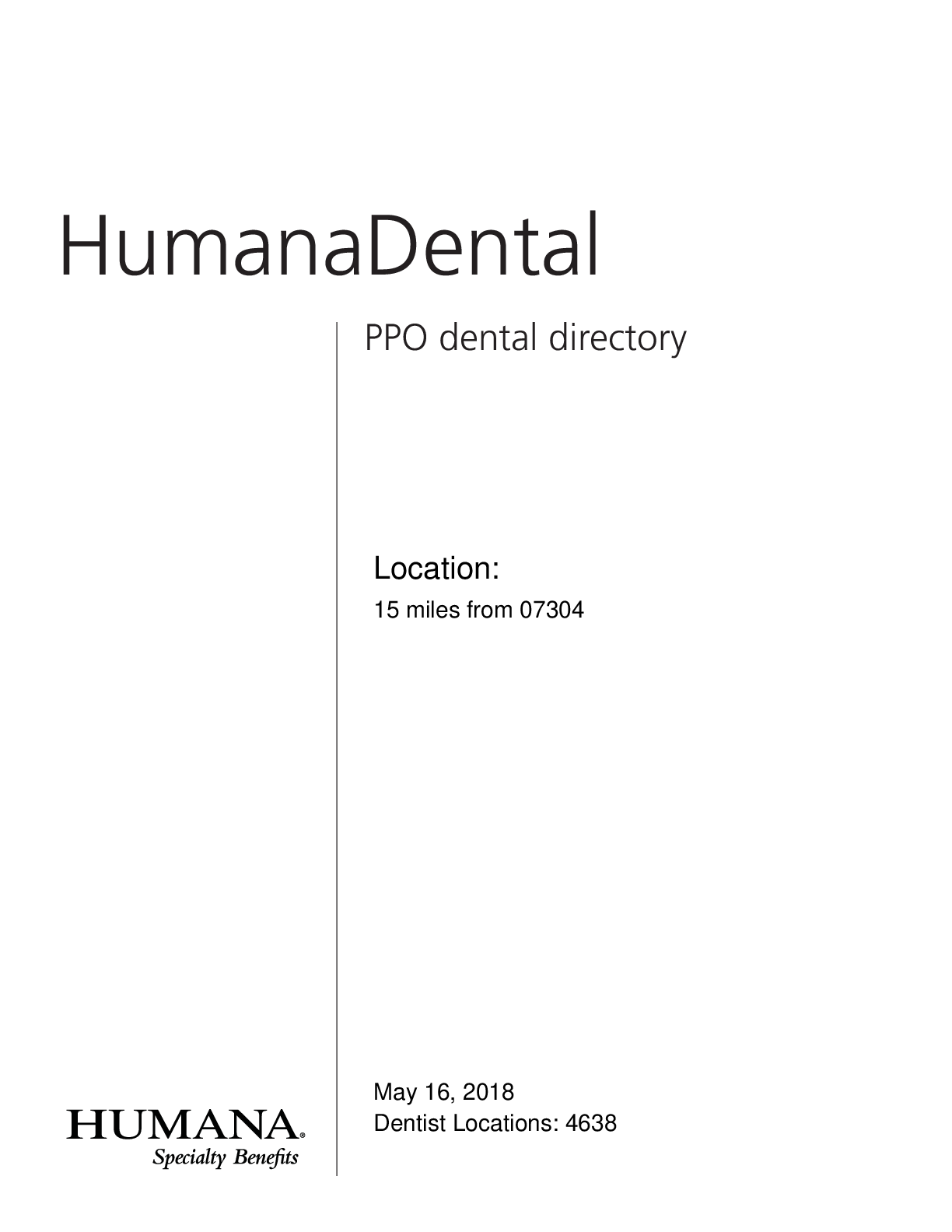
Dental list Yellow pages
HumanaDental PPO dental directory Location: 15 miles from 07304 May 16, 2018 Dentist Locations: 4638 Get the most out of your dental plan. the covered person must send us a letter requesting a...
By Academia1434 , Uploaded: Mar 30, 2021
$1
Statistics> Solutions Guide > MAT 240 Module Five Assignment Hypothesis Testing for Regional Real Estate Company (All)
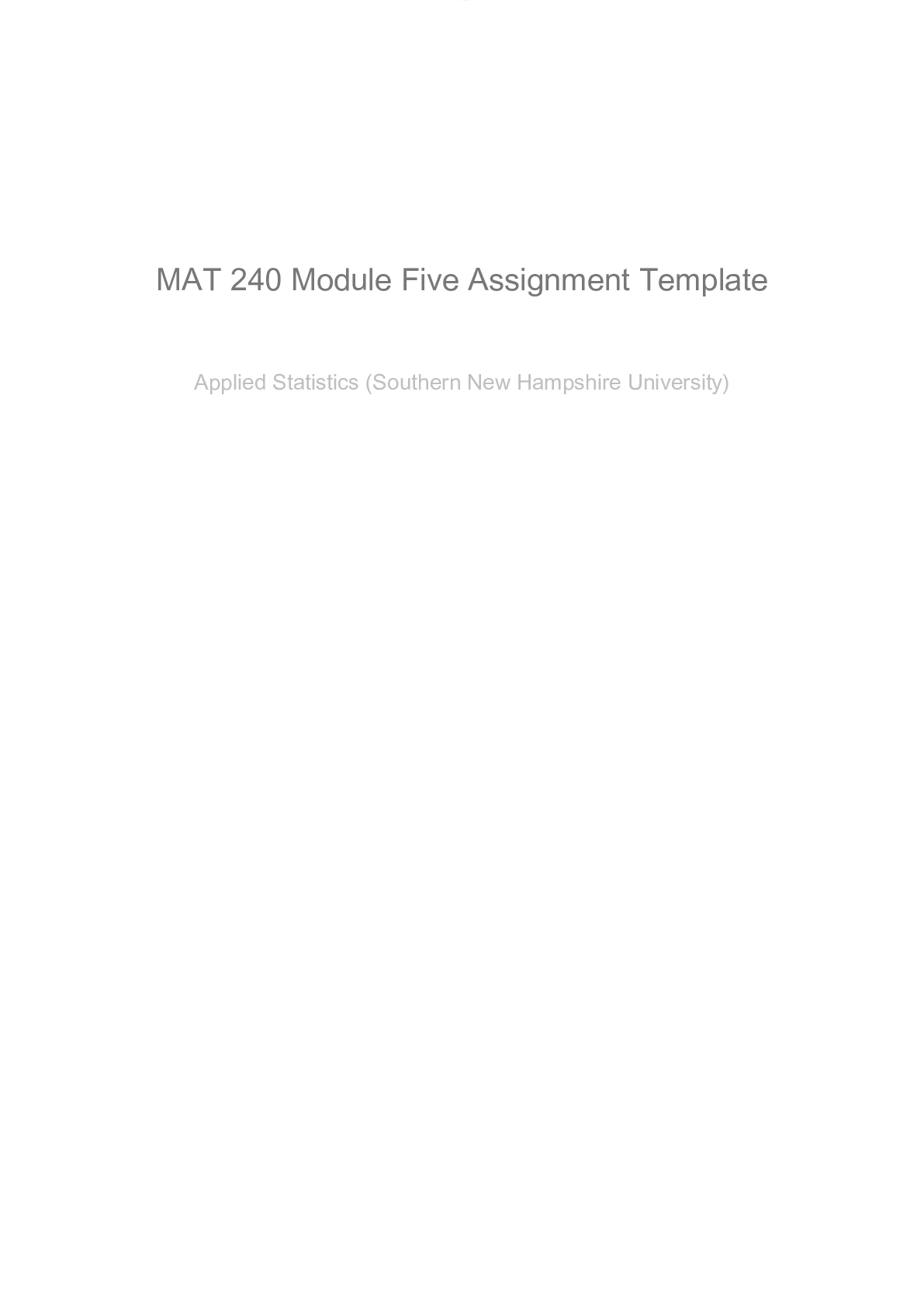
MAT 240 Module Five Assignment Hypothesis Testing for Regional Real Estate Company
Scenario You have been hired by the Regional Real Estate Company to help them analyze real estate data. One of the company’s Pacific region salespeople just returned to the office with a newly desi...
By ACADEMICTUTORIAL , Uploaded: May 26, 2022
$4
Finance> Solutions Guide > Week 4 Mini Case Complete The Chapter 9 (All)

Week 4 Mini Case Complete The Chapter 9
During the last few years, Jana Industries has been too constrained by the high cost of capital to make many capital investments. Recently, though, capital costs have been declining, and the company h...
By ACADEMICTUTORIAL , Uploaded: May 26, 2022
$3.5
Accounting> Solutions Guide > ACCT370 Excel Project Part 3 (All)

ACCT370 Excel Project Part 3
EXCEL PROJECT: PROJECTING FINANCIAL STATEMENTS ASSIGNMENT INSTRUCTIONS OVERVIEW Common Sized Balance Sheets (Tabs 12), Common Sized Income Statements (Tab 13), Horizontal Analysis Balanc...
By ACADEMICTUTORIAL , Uploaded: Feb 14, 2023
$6.5
Business> Solutions Guide > Read the Chapter 19 Mini Case in Financial Management: Theory and Practice (All)
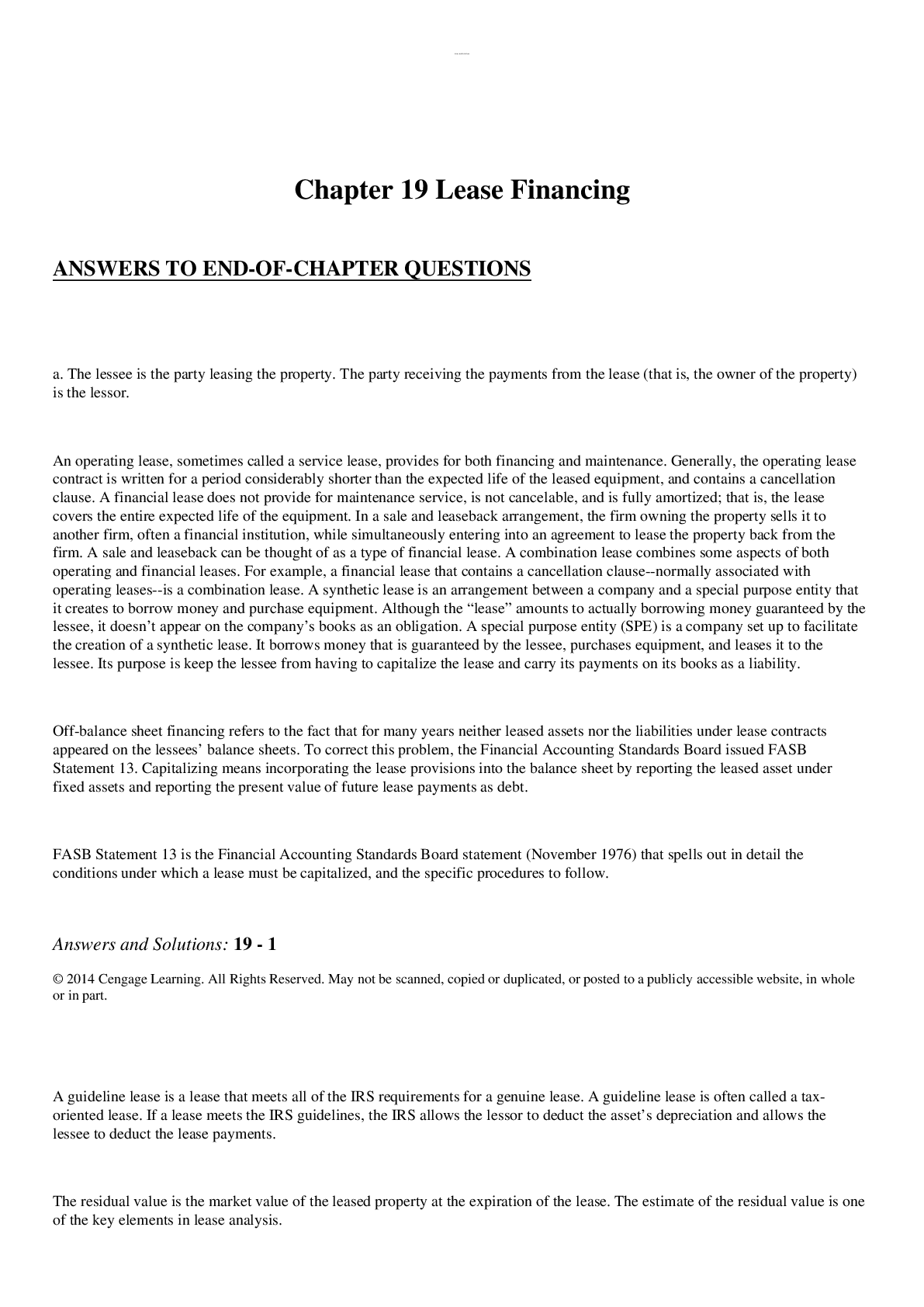
Read the Chapter 19 Mini Case in Financial Management: Theory and Practice
Chapter 18 leasing and financing Chapter 19 Mini Case in Financial Management Lewis Securities Inc Read the Chapter 19 Mini Case in Financial Management: Theory and Practice. Using complete sen...
By ACADEMICTUTORIAL , Uploaded: May 01, 2023
$5.5
Document information
Connected school, study & course
About the document
Uploaded On
Jun 29, 2022
Number of pages
166
Written in
Additional information
This document has been written for:
Uploaded
Jun 29, 2022
Downloads
0
Views
108






